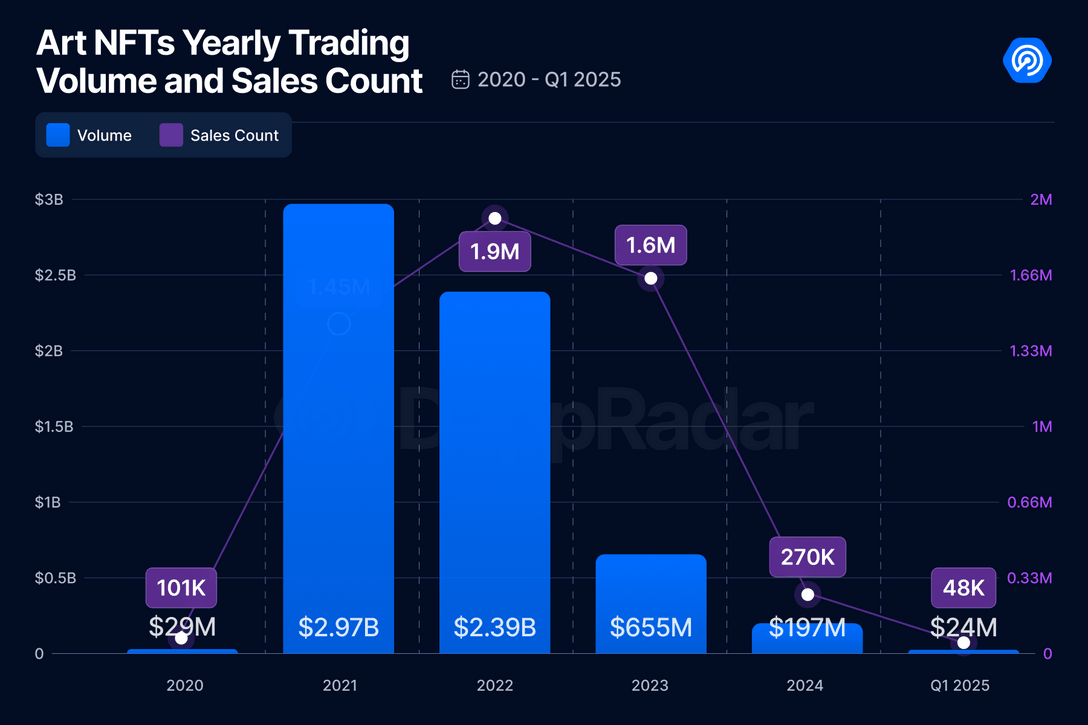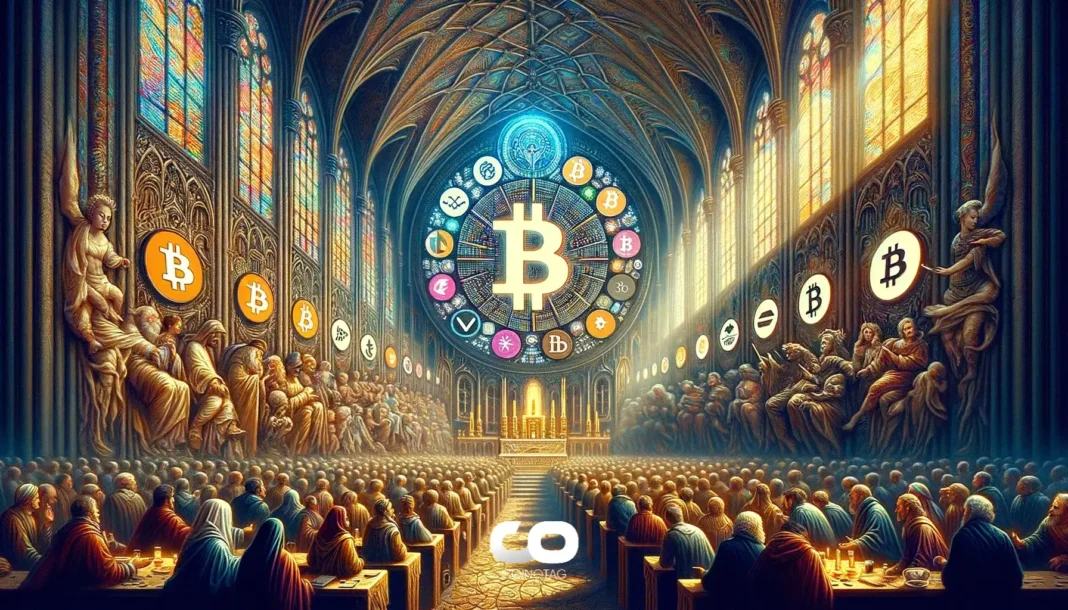| COINOTAG recommends • Exchange signup |
| 💹 Trade with pro tools |
| Fast execution, robust charts, clean risk controls. |
| 👉 Open account → |
| COINOTAG recommends • Exchange signup |
| 🚀 Smooth orders, clear control |
| Advanced order types and market depth in one view. |
| 👉 Create account → |
| COINOTAG recommends • Exchange signup |
| 📈 Clarity in volatile markets |
| Plan entries & exits, manage positions with discipline. |
| 👉 Sign up → |
| COINOTAG recommends • Exchange signup |
| ⚡ Speed, depth, reliability |
| Execute confidently when timing matters. |
| 👉 Open account → |
| COINOTAG recommends • Exchange signup |
| 🧭 A focused workflow for traders |
| Alerts, watchlists, and a repeatable process. |
| 👉 Get started → |
| COINOTAG recommends • Exchange signup |
| ✅ Data‑driven decisions |
| Focus on process—not noise. |
| 👉 Sign up → |
-
The NFT market has faced severe challenges, with trading volume plunging 93% from its 2021 highs, leading to significant changes in the landscape.
-
Industry experts suggest that this downturn signifies an evolution rather than an outright collapse, paving the way for more practical applications of NFTs.
-
In an interview, Rarible co-founder Alexander Salnikov stated, “We’re watching NFTs evolve into actual infrastructure—tools for creators to build communities and economies.”
Explore the evolving landscape of NFTs as trading volumes decline sharply, prompting a strategic pivot towards community-focused utilities and real-world applications.
NFT Market Decline: A New Chapter in the Digital Asset Journey
After experiencing unprecedented growth during the 2021 crypto boom, the NFT sector is undergoing a crucial transformation. The rapid rise in trading volumes was immediately followed by a stark correction, raising questions about the market’s sustainability and future direction.
According to a recent DappRadar report, the art NFT market peaked at a staggering $2.9 billion in 2021. However, the market has since suffered a dramatic decline, capturing only $23.8 million in trading volume by the first quarter of 2025, demonstrating a staggering decrease of 93%.

| COINOTAG recommends • Professional traders group |
| 💎 Join a professional trading community |
| Work with senior traders, research‑backed setups, and risk‑first frameworks. |
| 👉 Join the group → |
| COINOTAG recommends • Professional traders group |
| 📊 Transparent performance, real process |
| Spot strategies with documented months of triple‑digit runs during strong trends; futures plans use defined R:R and sizing. |
| 👉 Get access → |
| COINOTAG recommends • Professional traders group |
| 🧭 Research → Plan → Execute |
| Daily levels, watchlists, and post‑trade reviews to build consistency. |
| 👉 Join now → |
| COINOTAG recommends • Professional traders group |
| 🛡️ Risk comes first |
| Sizing methods, invalidation rules, and R‑multiples baked into every plan. |
| 👉 Start today → |
| COINOTAG recommends • Professional traders group |
| 🧠 Learn the “why” behind each trade |
| Live breakdowns, playbooks, and framework‑first education. |
| 👉 Join the group → |
| COINOTAG recommends • Professional traders group |
| 🚀 Insider • APEX • INNER CIRCLE |
| Choose the depth you need—tools, coaching, and member rooms. |
| 👉 Explore tiers → |
Similarly, there has been a notable decrease in active traders, from a record high of 529,101 in 2022 to just 19,575 by Q1 2025, representing a 96% fall. DappRadar also indicated that 2024 marked one of the weakest years for the NFT market since its inception, with a staggering 98% of projects launched that year failing to take off.
Despite these alarming statistics, Rarible’s Salnikov maintains optimism for the future of NFTs. He argues the sector is in a phase of reevaluation rather than collapse. “The speculative phase had its moment, but now we’re observing NFTs transform into tools for real utility,” he stated, emphasizing the importance of clear purpose in the NFT space.
| COINOTAG recommends • Exchange signup |
| 📈 Clear interface, precise orders |
| Sharp entries & exits with actionable alerts. |
| 👉 Create free account → |
| COINOTAG recommends • Exchange signup |
| 🧠 Smarter tools. Better decisions. |
| Depth analytics and risk features in one view. |
| 👉 Sign up → |
| COINOTAG recommends • Exchange signup |
| 🎯 Take control of entries & exits |
| Set alerts, define stops, execute consistently. |
| 👉 Open account → |
| COINOTAG recommends • Exchange signup |
| 🛠️ From idea to execution |
| Turn setups into plans with practical order types. |
| 👉 Join now → |
| COINOTAG recommends • Exchange signup |
| 📋 Trade your plan |
| Watchlists and routing that support focus. |
| 👉 Get started → |
| COINOTAG recommends • Exchange signup |
| 📊 Precision without the noise |
| Data‑first workflows for active traders. |
| 👉 Sign up → |
Transition from Speculation to Utility: The Future of NFTs
Salnikov advocates for a future where NFTs serve practical purposes, including memberships, loyalty programs, and digital identities within games. He underscored the importance of integrating NFTs into everyday life, echoing the sentiments of a wider industry trend toward real-world applications.
A report from Binance Research further substantiates these claims, revealing burgeoning partnerships in the physical realm that include notable collaborations such as Azuki’s physical-backed NFT and The Sandbox’s engagement with major franchises. “The next wave of growth isn’t about chasing a trend—it’s about redefining ownership models for the internet generation,” Salnikov observed.
| COINOTAG recommends • Traders club |
| ⚡ Futures with discipline |
| Defined R:R, pre‑set invalidation, execution checklists. |
| 👉 Join the club → |
| COINOTAG recommends • Traders club |
| 🎯 Spot strategies that compound |
| Momentum & accumulation frameworks managed with clear risk. |
| 👉 Get access → |
| COINOTAG recommends • Traders club |
| 🏛️ APEX tier for serious traders |
| Deep dives, analyst Q&A, and accountability sprints. |
| 👉 Explore APEX → |
| COINOTAG recommends • Traders club |
| 📈 Real‑time market structure |
| Key levels, liquidity zones, and actionable context. |
| 👉 Join now → |
| COINOTAG recommends • Traders club |
| 🔔 Smart alerts, not noise |
| Context‑rich notifications tied to plans and risk—never hype. |
| 👉 Get access → |
| COINOTAG recommends • Traders club |
| 🤝 Peer review & coaching |
| Hands‑on feedback that sharpens execution and risk control. |
| 👉 Join the club → |
While this forward-looking perspective is encouraging, the market hasn’t fully recovered. Platforms like Bybit and X2Y2 have ended their NFT services due to dwindling trading activity, while others have sought alternative business models, making adjustments to remain relevant. Nevertheless, Salnikov believes there’s a fundamental transformation occurring within the NFT commerce space.
Navigating Post-Hype Challenges: Celebrity NFTs and Their Impact
Celebrity endorsements, once thought to be a boon for the NFT market, have turned out to be a double-edged sword. High-profile NFT investments made by celebrities like Justin Bieber have seen dramatic declines in value, prompting scrutiny over the sustainability of such trends.
For instance, Bieber’s purchase of Bored Ape #3001 for 500 ETH in January 2022 is now valued at only 13.51 WETH, marking a staggering loss of 98%. This downturn emphasizes that celebrity power alone cannot guarantee the longevity of an NFT’s value.
As Salnikov pointed out, the NFT market’s long-term health relies not on flashing celebrity endorsements but on building communities and producing substantive projects. “Celebrity drops will come and go—it’s the underlying culture and community that determines if they last,” he remarked.
| COINOTAG recommends • Exchange signup |
| 📈 Clear control for futures |
| Sizing, stops, and scenario planning tools. |
| 👉 Open futures account → |
| COINOTAG recommends • Exchange signup |
| 🧩 Structure your futures trades |
| Define entries & exits with advanced orders. |
| 👉 Sign up → |
| COINOTAG recommends • Exchange signup |
| 🛡️ Control volatility |
| Automate alerts and manage positions with discipline. |
| 👉 Get started → |
| COINOTAG recommends • Exchange signup |
| ⚙️ Execution you can rely on |
| Fast routing and meaningful depth insights. |
| 👉 Create account → |
| COINOTAG recommends • Exchange signup |
| 📒 Plan. Execute. Review. |
| Frameworks for consistent decision‑making. |
| 👉 Join now → |
| COINOTAG recommends • Exchange signup |
| 🧩 Choose clarity over complexity |
| Actionable, pro‑grade tools—no fluff. |
| 👉 Open account → |
He further stressed the importance of creating genuine connections through NFTs rather than treating them merely as merchandise. This approach could foster a more sustainable ecosystem, one where authenticity and creativity thrive.
Enhancing User Experience: The Road to Broader Adoption
The Rarible co-founder stressed the need for a user-friendly approach to attract newcomers to the NFT space. He argued that onboarding should not feel overwhelming and that platforms must prioritize creating user-friendly environments. Rarible allocates resources toward ensuring their marketplace is intuitive and resonates with user needs, illustrating a commitment to enhancing user experiences.
| COINOTAG recommends • Members‑only research |
| 📌 Curated setups, clearly explained |
| Entry, invalidation, targets, and R:R defined before execution. |
| 👉 Get access → |
| COINOTAG recommends • Members‑only research |
| 🧠 Data‑led decision making |
| Technical + flow + context synthesized into actionable plans. |
| 👉 Join now → |
| COINOTAG recommends • Members‑only research |
| 🧱 Consistency over hype |
| Repeatable rules, realistic expectations, and a calmer mindset. |
| 👉 Get access → |
| COINOTAG recommends • Members‑only research |
| 🕒 Patience is an edge |
| Wait for confirmation and manage risk with checklists. |
| 👉 Join now → |
| COINOTAG recommends • Members‑only research |
| 💼 Professional mentorship |
| Guidance from seasoned traders and structured feedback loops. |
| 👉 Get access → |
| COINOTAG recommends • Members‑only research |
| 🧮 Track • Review • Improve |
| Documented PnL tracking and post‑mortems to accelerate learning. |
| 👉 Join now → |
“We’re not just selling NFTs—we’re creating holistic experiences that integrate seamlessly with user lifestyles,” Salnikov concluded, positioning Rarible as a leader in a new era of NFT commerce focused on real-world utility and community building.
As the NFT landscape continues to evolve, the focus on genuine utility and user engagement may pave the way for a renaissance within the industry, suggesting that the future could be bright for creators and collectors alike.
| COINOTAG recommends • Exchange signup |
| 🎯 Focus on process over noise |
| Plan trades, size positions, execute consistently. |
| 👉 Sign up → |
| COINOTAG recommends • Exchange signup |
| 🛠️ Simplify execution |
| Keep decisions clear with practical controls. |
| 👉 Get started → |
| COINOTAG recommends • Exchange signup |
| 📊 Make data your edge |
| Use depth and alerts to avoid guesswork. |
| 👉 Open account → |
| COINOTAG recommends • Exchange signup |
| 🧭 Be prepared, not reactive |
| Turn setups into rules before you trade. |
| 👉 Create account → |
| COINOTAG recommends • Exchange signup |
| ✍️ Plan first, then act |
| Entries, exits, and reviews that fit your routine. |
| 👉 Join now → |
| COINOTAG recommends • Exchange signup |
| 🧩 Consistency beats intensity |
| Small, repeatable steps win the long run. |
| 👉 Sign up → |
Conclusion
In conclusion, while the NFT market is currently facing considerable challenges, the shift toward practicality and real-world use suggests a transformative phase for digital assets. As the sector recalibrates, the emphasis on community engagement and authentic value may not only revitalize interest but also lay a solid foundation for long-term growth.
| COINOTAG recommends • Members‑only research |
| 📌 Curated setups, clearly explained |
| Entry, invalidation, targets, and R:R defined before execution. |
| 👉 Get access → |
| COINOTAG recommends • Members‑only research |
| 🧠 Data‑led decision making |
| Technical + flow + context synthesized into actionable plans. |
| 👉 Join now → |
| COINOTAG recommends • Members‑only research |
| 🧱 Consistency over hype |
| Repeatable rules, realistic expectations, and a calmer mindset. |
| 👉 Get access → |
| COINOTAG recommends • Members‑only research |
| 🕒 Patience is an edge |
| Wait for confirmation and manage risk with checklists. |
| 👉 Join now → |
| COINOTAG recommends • Members‑only research |
| 💼 Professional mentorship |
| Guidance from seasoned traders and structured feedback loops. |
| 👉 Get access → |
| COINOTAG recommends • Members‑only research |
| 🧮 Track • Review • Improve |
| Documented PnL tracking and post‑mortems to accelerate learning. |
| 👉 Join now → |







